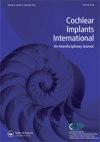求助PDF
{"title":"人工与机器人辅助人工耳蜗植入中前庭功能保存的比较研究。","authors":"Arthur Derieppe, Adrien Gendre, Kinnie Bourget-Aguilar, Philippe Bordure, Guillaume Michel","doi":"10.1080/14670100.2023.2271221","DOIUrl":null,"url":null,"abstract":"<p><strong>Objective: </strong>To compare vestibular outcomes in cochlear implant (CI) surgery, between robotic-assisted insertion of the electrodes versus manual insertion.</p><p><strong>Methods: </strong>We performed a monocentric retrospective study. From March 2021, the robotic system RobOtol© was used for all CI cases. We compared this robotic-assisted insertion group with a manual insertion group of patients who received a CI between July 2020 and March 2021. Primary objective was vestibular outcome. We used objective vestibular function tests: caloric testing, Vestibular Evoked Myogenic Potential (VEMP), and Video Head Impulse Test (VHIT). Secondary objectives were postoperative complications including patient-reported postoperative vertigo.</p><p><strong>Results: </strong>We found no statistically significant difference between the two groups in terms of caloric testing, VEMP or VHIT outcomes. In patient-reported outcomes, there was significantly more vertigo in the manual insertion group compared with robotic-assisted insertion.</p><p><strong>Conclusion: </strong>It is hypothesized that a non-traumatic insertion would cause less vestibular dysfunction postoperatively. Larger prospective studies are required to determine whether robotic-assisted CI insertion has a significant impact on vestibular outcomes in CI surgery.</p>","PeriodicalId":53553,"journal":{"name":"COCHLEAR IMPLANTS INTERNATIONAL","volume":" ","pages":"23-27"},"PeriodicalIF":1.4000,"publicationDate":"2024-01-01","publicationTypes":"Journal Article","fieldsOfStudy":null,"isOpenAccess":false,"openAccessPdf":"","citationCount":"0","resultStr":"{\"title\":\"Comparative study of vestibular function preservation in manual versus robotic-assisted cochlear implantation.\",\"authors\":\"Arthur Derieppe, Adrien Gendre, Kinnie Bourget-Aguilar, Philippe Bordure, Guillaume Michel\",\"doi\":\"10.1080/14670100.2023.2271221\",\"DOIUrl\":null,\"url\":null,\"abstract\":\"<p><strong>Objective: </strong>To compare vestibular outcomes in cochlear implant (CI) surgery, between robotic-assisted insertion of the electrodes versus manual insertion.</p><p><strong>Methods: </strong>We performed a monocentric retrospective study. From March 2021, the robotic system RobOtol© was used for all CI cases. We compared this robotic-assisted insertion group with a manual insertion group of patients who received a CI between July 2020 and March 2021. Primary objective was vestibular outcome. We used objective vestibular function tests: caloric testing, Vestibular Evoked Myogenic Potential (VEMP), and Video Head Impulse Test (VHIT). Secondary objectives were postoperative complications including patient-reported postoperative vertigo.</p><p><strong>Results: </strong>We found no statistically significant difference between the two groups in terms of caloric testing, VEMP or VHIT outcomes. In patient-reported outcomes, there was significantly more vertigo in the manual insertion group compared with robotic-assisted insertion.</p><p><strong>Conclusion: </strong>It is hypothesized that a non-traumatic insertion would cause less vestibular dysfunction postoperatively. Larger prospective studies are required to determine whether robotic-assisted CI insertion has a significant impact on vestibular outcomes in CI surgery.</p>\",\"PeriodicalId\":53553,\"journal\":{\"name\":\"COCHLEAR IMPLANTS INTERNATIONAL\",\"volume\":\" \",\"pages\":\"23-27\"},\"PeriodicalIF\":1.4000,\"publicationDate\":\"2024-01-01\",\"publicationTypes\":\"Journal Article\",\"fieldsOfStudy\":null,\"isOpenAccess\":false,\"openAccessPdf\":\"\",\"citationCount\":\"0\",\"resultStr\":null,\"platform\":\"Semanticscholar\",\"paperid\":null,\"PeriodicalName\":\"COCHLEAR IMPLANTS INTERNATIONAL\",\"FirstCategoryId\":\"1085\",\"ListUrlMain\":\"https://doi.org/10.1080/14670100.2023.2271221\",\"RegionNum\":0,\"RegionCategory\":null,\"ArticlePicture\":[],\"TitleCN\":null,\"AbstractTextCN\":null,\"PMCID\":null,\"EPubDate\":\"2023/11/20 0:00:00\",\"PubModel\":\"Epub\",\"JCR\":\"Q2\",\"JCRName\":\"OTORHINOLARYNGOLOGY\",\"Score\":null,\"Total\":0}","platform":"Semanticscholar","paperid":null,"PeriodicalName":"COCHLEAR IMPLANTS INTERNATIONAL","FirstCategoryId":"1085","ListUrlMain":"https://doi.org/10.1080/14670100.2023.2271221","RegionNum":0,"RegionCategory":null,"ArticlePicture":[],"TitleCN":null,"AbstractTextCN":null,"PMCID":null,"EPubDate":"2023/11/20 0:00:00","PubModel":"Epub","JCR":"Q2","JCRName":"OTORHINOLARYNGOLOGY","Score":null,"Total":0}
引用次数: 0
引用
批量引用
Comparative study of vestibular function preservation in manual versus robotic-assisted cochlear implantation.
Objective: To compare vestibular outcomes in cochlear implant (CI) surgery, between robotic-assisted insertion of the electrodes versus manual insertion.
Methods: We performed a monocentric retrospective study. From March 2021, the robotic system RobOtol© was used for all CI cases. We compared this robotic-assisted insertion group with a manual insertion group of patients who received a CI between July 2020 and March 2021. Primary objective was vestibular outcome. We used objective vestibular function tests: caloric testing, Vestibular Evoked Myogenic Potential (VEMP), and Video Head Impulse Test (VHIT). Secondary objectives were postoperative complications including patient-reported postoperative vertigo.
Results: We found no statistically significant difference between the two groups in terms of caloric testing, VEMP or VHIT outcomes. In patient-reported outcomes, there was significantly more vertigo in the manual insertion group compared with robotic-assisted insertion.
Conclusion: It is hypothesized that a non-traumatic insertion would cause less vestibular dysfunction postoperatively. Larger prospective studies are required to determine whether robotic-assisted CI insertion has a significant impact on vestibular outcomes in CI surgery.


